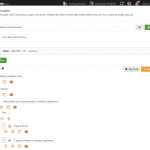
Selecting Which FMEAs to Do
FMEAs take time and cost money. They should be done when a certain level of risk can be effectively addressed by the FMEA procedure. Preliminary Risk Assessment is a procedure that uses company-determined criteria to select which FMEAs to do.
“The key is to schedule your priorities.” ― Steven Covey













 Ask a question or send along a comment.
Please login to view and use the contact form.
Ask a question or send along a comment.
Please login to view and use the contact form.